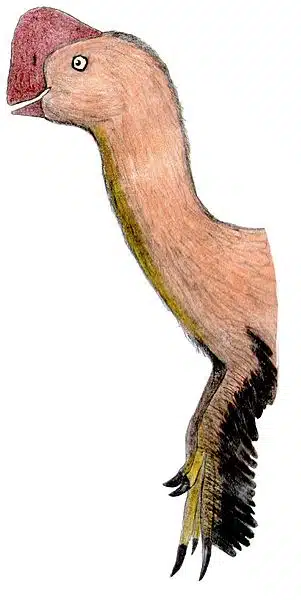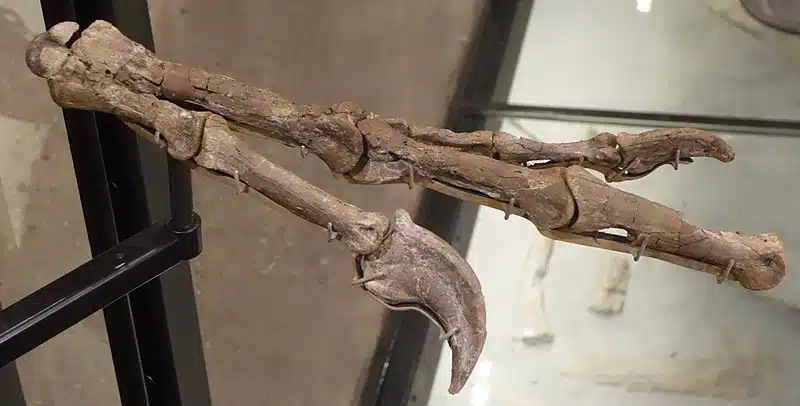Diving into the prehistoric world, we often stumble upon fascinating creatures that roamed the Earth millions of years ago. One such intriguing dinosaur is Hagryphus, with a name that resonates with the mystique of ancient mythologies. Discovered relatively recently, this Theropod dinosaur offers a unique glimpse into the diverse and complex ecosystems of the Late Cretaceous Period.
Hagryphus, whose name means “Ha’s Griffin,” presents a captivating blend of historical and mythological naming conventions. Its discovery in the early 21st century added a new dimension to our understanding of the diverse Theropod group. This omnivorous creature belonged to the Caenagnathid family and roamed the Earth during a time when dinosaurs were the dominant terrestrial vertebrates.
Hagryphus Key Facts
| Keyword | Fact |
|---|---|
| Pronunciation | Hag-Riff-Us |
| Meaning of name | Ha’s Griffin |
| Group | Theropod |
| Type Species | Hagryphus giganteus |
| Diet | Omnivore |
| When it Lived | 83.5 to 70.6 MYA |
| Period | Late Cretaceous |
| Epoch | Late/Upper Campanian |
| Length | 10.0 feet |
| Height | Approximately 6.0 feet |
| Weight | Approximately 110.0 lbs |
| Mobility | Moved on two legs |
| First Discovery | 2002 by Michael Getty |
| Described by | 2005 by Lindsay Zanno and Scott Sampson |
| Holotype | UMNH VP 12765 |
| Location of first find | Kaiparowits Formation, Grand Staircase-Escalante National Monument, Utah |
Hagryphus Origins, Taxonomy and Timeline
This name is derived from the Egyptian god of the desert, Ha, and the Greek/Roman mythological creature, the griffin. This nomenclature not only reflects the dinosaur’s perceived characteristics but also bridges a connection between ancient cultures and prehistoric life.

In the realm of scientific classification, Hagryphus falls under the Theropod group, specifically within the Caenagnathid family. This categorization places it among a diverse group of bipedal dinosaurs known for their varied diets and sizes. The specific species in focus here is Hagryphus giganteus.
The timeline of Hagryphus spans the Late Cretaceous Period, specifically the Late Campanian Epoch. This era, ranging from 83.5 to 70.6 million years ago, was a time of significant diversification and evolution among dinosaur species. This dinosaur lived in an era marked by dynamic ecological changes, which undoubtedly influenced its lifestyle and behaviors.
Discovery & Fossil Evidence
Discovered by Michael Getty in 2002, the remains of this intriguing dinosaur were unearthed in the fossil-rich layers of the Kaiparowits Formation within the Grand Staircase–Escalante National Monument in southern Utah. This region is known for its Late Campanian deposits and has been a treasure trove for paleontologists. It offers glimpses into a world 75.95 million years old, as indicated by radiometric dating of the rocks near where Hagryphus was found.
The formal naming and description of Hagryphus giganteus, the only species identified within this genus so far, was undertaken by Lindsay Zanno and Scott Sampson in 2005. Their work not only classified this new species but also gave it a name rich in cultural and mythological significance.
The holotype is housed in the Utah Museum of Natural History in Salt Lake City. This specimen, while incomplete, provides valuable insights into the anatomy of this dinosaur. It includes an articulated left hand and the distal portion of the left radius. Notably, the hand lacks the second claw. Additionally, some fragmentary foot elements, discovered near the hand on the hillside, have been included under the same inventory number.
- Fossil specimen in the Natural History Museum of Utah, Salt Lake City, Utah, USA. Photography was permitted in the museum without restriction.
- Holotype specimen on display at Natural History Museum of Utah, Salt Lake City
- Left hand of the reconstructed skeleton
- Hagryphus giganteus reconstruction, detail of hand, on display at the Natural History Museum of Utah, Salt Lake City.
Hagryphus Size and Description
While only known from parts of its limb, reconstructions of this dinosaur based on its relatives paint an impressive picture. As the name Hagryphus giganteus suggests, this large Oviraptorosaur is a great example of the diversity of life in the Late Cretaceous near the end of the Age of Dinosaurs.
Size and Weight of Type Species

Initially, this dinosaur was estimated to be around 10.0 feet long, positioning it as one of the largest members of the Oviraptorosauria clade, second only to the later described Gigantoraptor. This size estimate places Hagryphus at about 30-40% larger than the next largest known North American Oviraptorosaur, Chirostenotes.
However, these dimensions have been subject to revision. In 2010, Gregory S. Paul proposed a slightly smaller size for this dinosaur, estimating its length at 8.0 feet and its weight at around 110.0 pounds. This revised estimate, while still indicating a significant size, suggests a somewhat more modest stature than initially thought. The variation in size estimates highlights the challenges and evolving nature of paleontological reconstructions, especially when based on incomplete fossil records. Nonetheless, even at this reduced size, Hagryphus remains a remarkable example of the diversity and scale found within the Theropod dinosaurs.
The Dinosaur in Detail
The members of the diverse Oviraptorosauria clade present a fascinating study in Theropod anatomy and adaptation and Hagryphus is no exception. Its physical characteristics, while partially reconstructed from incomplete fossils, suggest a creature adept at navigating its Late Cretaceous environment. The bipedal stance of Hagryphus indicates potential for considerable agility, a trait likely beneficial for an omnivorous diet in a dynamic ecosystem.
The unique features of Hagryphus, particularly its hand structure, set it apart from other members of its clade. The hand of the holotype measures about a foot long and points to a level of dexterity that may have been crucial for foraging or hunting. These physical attributes not only distinguish Hagryphus from its contemporaries but also provide insights into the evolutionary adaptability and survival strategies of Theropods.
Interesting Points about Hagryphus
- Its name is inspired by Egyptian mythology and mythological creatures. This reflects a unique blend of cultural and paleontological naming conventions.
- Its discovery in the Kaiparowits Formation highlights the region’s rich fossil record and the diversity of Theropods during the Late Cretaceous.
- The likely bipedal nature suggests a level of agility and adaptability, key traits for an omnivorous diet in a dynamic ecosystem.
- As a member of the Caenagnathid family, Hagryphus contributes to our understanding of the varied lifestyles and evolutionary paths within the theropod group.
- The incomplete fossil record leaves room for speculation and further discovery, making it a subject of ongoing interest in paleontology.
Hagryphus in its Natural Habitat
This omnivorous dinosaur inhabited the diverse and dynamic landscapes of North America in the Late Cretaceous Period. This era was characterized by a range of climates and geographies, from lush forests to arid deserts. The vegetation during this time was diverse, providing a rich source of food for various dinosaur species.
As an omnivore, Hagryphus would have had a varied diet and fed on both plants and smaller animals. Its bipedal locomotion suggests it could have been both a nimble predator and a forager, adapting its hunting and feeding strategies to the available resources. The social behavior of Hagryphus is not well-documented, but it could have ranged from solitary to social depending on the environmental conditions and food availability. Its interactions with other species, both as a competitor and a predator, would have influenced the ecological balance of its environment.
Contemporary Dinosaurs
This dinosaur’s days were spent in a dynamic dance of survival and interaction with some fascinating contemporaries. Among these were Hypacrosaurus, Judiceratops, and Kosmoceratops, each playing a unique role in the ecosystem that Hagryphus called home.

Smaller and more agile than its contemporaries, it likely had a different diet and lifestyle. Hypacrosaurus, for instance, was a larger duck-billed herbivore that peacefully munched on vegetation. This size difference meant that Hagryphus didn’t directly compete with Hypacrosaurus for food. Instead, it might have scavenged leftovers or hunted smaller prey, coexisting rather harmoniously in terms of dietary needs. Then there were Judiceratops and Kosmoceratops. Both were Ceratopsians known for their impressive horns and frills. These dinosaurs were also larger than Hagryphus and probably focused on low-lying plants, leaving different food sources for our dinosaur to exploit.
But life wasn’t all about food. While Hagryphus wasn’t the top predator, its swiftness and agility could have been its best defense against larger predators. There’s a chance that it might have had to be wary of larger Theropods. Meanwhile, its interactions with the Ceratopsians could have ranged from indifferent to cautious. The Ceratopsians, with their formidable horns, were not to be trifled with even if Hagryphus was just passing by. This dynamic world where size, diet, and behavior dictated the relationships between these ancient creatures paints a vivid picture of life in the time of Hagryphus and its contemporaries.
Frequently Asked Questions
It means “Ha’s Griffin,” combining the name of the Egyptian god of the desert, Ha, with the mythological creature, the griffin.
Hagryphus lived during the Late Cretaceous Period, specifically from 83.5 to 70.6 million years ago.
It was discovered in the Kaiparowits Formation, located in the Grand Staircase-Escalante National Monument, Utah.
This is a Theropod dinosaur belonging to the Caenagnathid family.
As an omnivore, it likely had a diet consisting of both plants and smaller animals.
Sources
The information in this article is based on various sources, drawing on scientific research, fossil evidence, and expert analysis. The aim is to provide a comprehensive and accurate overview of Hagryphus. However, please be aware that our understanding of dinosaurs and their world is constantly evolving as new discoveries are made.
- https://www.researchgate.net/publication/229289411_A_new_Oviraptorosaur_Theropoda_Maniraptora_from_the_Late_Cretaceous_Campanian_of_Utah
- https://www.ncbi.nlm.nih.gov/pmc/articles/PMC3176273/
- https://www.semanticscholar.org/paper/Caenagnathids-of-the-Dinosaur-Park-Formation-of-and-Funston/96a5ba55aa4b71016024a6e12873cac070e8380d
This article was last fact-checked: Joey Arboleda, 12-06-2023
Featured Image Credit: ABelov2014, CC BY 3.0, via Wikimedia Commons




